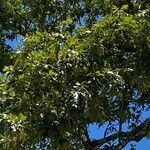Large tree, to 30 m; bark dark, thick, the rough ridges separated by deep, narrow furrows; twigs of the season persistently pubescent; lvs highly variable, commonly with 1–4 pairs of lateral lobes, these and especially the terminal lobe elongate, 2–5 times as long as wide, the lateral ones rather narrowly triangular and long-tapering, the terminal one more oblong and tending to be somewhat falcate; lvs persistently cinereous-tomentose beneath and on the long (2–5 cm) petiole; acorns 1–1.5 cm, about a third covered by the deeply saucer-shaped cup. Dry or sandy soil in the e., more often in wet soil in the w.; N.J. and sw. Pa. to Fla. and Tex., chiefly on the coastal plain, n. in the interior to O., Ind., and Mo. (Q. rubra, misapplied; Q. triloba)
A deciduous tree. It grows 25 m high. It is a broadly spreading oak tree. The bark is dark grey-brown and has cracks. These form narrow ridges. The leaves are narrowly oval and 20 cm long by 15 cm across. They are deeply divided into lobes. They are dark green and smooth above and have brown or grey hairs underneath. The male and female flowers are separate on the same plant. The males are more obvious in yellow-green catkins which droop. The fruit is an acorn 2 cm long. It is about one third enclosed in a narrow cup.


